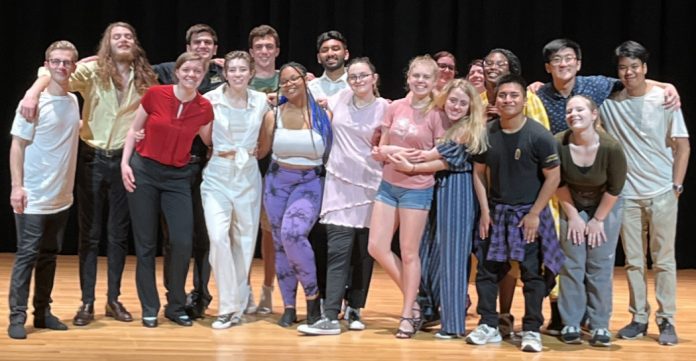Performing in Sadler Center’s Commonwealth Auditorium Friday, April 7, members of the College of William and Mary’s Salsa Club presented four styles of Latin social dances to the broader campus community. The event was both a dance recital and a cultural showcase.
The dancers performed salsa, bachata, merengue and rueda routines in groups. Group sizes ranged from intimate, two-person bachata sets to a massive finale in which the roughly 100-person audience was invited to join the performers for a line dance to the popular reggaeton song “Danza Kuduro.” Between each dance, Publicity Chair Mai Kubin ’26 and Event Coordinator Siv Sandlin ’25 provided the audience with essential information about the historical context of each dance, including their countries of origin and stylistic influences.
The dances that Salsa Club members do are defined as social dances, meaning that they are meant to be performed in communal settings, usually among strangers. This practice stems from how these dances primarily developed in public spaces such as nightclubs and bars. In the case of bachata, it even developed in brothels due to political repression forcing practitioners underground.
“There is no choreography — it’s all improvisation, you’re dancing with random people most of the time, people that you’ve never met before,” Salsa Club President Tyler Cattini ’25 said when describing the typical environment in which these Latin dances are usually performed. “So it’s called social dancing; you just go out, and you have fun.”
Despite the free-form roots of the dances that Salsa Club presented, most of the pieces in the showcase were choreographed. Nevertheless, the routines were still developed via experimentation with dance moves and music until the event organizers reached a point they were satisfied with.
“We met up one day and just played around with some moves,” Kubin said when discussing the process of choreographing the group bachata piece. “We just did that for a while until we found some moves that we liked and arranged it in an order that worked.”
Though the spring showcase is an established annual event for the club, organizing it this year was still a challenging process. Some of the club’s leadership team was elected only recently, and the event required much coordination and collaboration between Sandlin, Kubin and Cattini. The officers involved the club’s general body members in the event preparation by gauging interest in which dances everyone wanted to perform and assessing each dancer’s skill level. After assigning dance groups, they held separate practices outside of regular club meetings, with multiple students in charge of choreographing routines.
The club’s regular meetings focus on teaching members new types of dances as well as filling in the gaps in each dance’s history. At the beginning of each semester, the club begins teaching its members the basics of salsa, bachata, merengue and rueda. The Salsa Club assumes no prior experience with Latin dance and allows dancers of all skill levels to mix and practice together. As the semester progresses, members are introduced to more complicated maneuvers that allow for additional flair. Although some members branch out and try their hand at lesser known Latin and Afro-Cuban dance styles in smaller groups, the main group continues to work on the four core dance styles throughout the semester so that every member can perform them at the semesterly showcase.
Because Salsa Club considers itself a cultural club, it works not only to perform Latin dances, but also to educate its members and the broader College community on the dances’ backgrounds. Both components of the organization’s mission are meant to combine into a genuine, shared appreciation of Latin dance culture while fostering member participation. By interspersing history lessons between dances at the showcase, the club displayed its commitment to teaching the differences between Latin dances to a broader audience.
“We share cultures,” Sandlin said. “We’re not scared of trying new dances… We would love to show everyone this part of [the] culture with this dance you really enjoy.”
Bachata, the first dance performed at the showcase, grew out of the Dominican Republic in the 1960s. This dance featured slower beats and focused more on partner work than the others. Additionally, the set offered ample opportunity for dancers to include higher-level techniques, such as twirling and tilting.
“For bachata specifically, it’s more of a smooth, sensual dance with a heavy rhythm to it whereas salsa, or merengue or rueda [are] more of a fast-paced, party dancing,” Cattini said.
Next was the club’s titular salsa, which developed in Cuba in the 1920s. The presenters stressed the diverse background of this dance, highlighting its Afro-Cuban stylistic origins in particular. Additionally, modern salsa was modified by other communities within Latin America and evolved to its current form thanks to its widespread practice by the Latino communities of New York City, Puerto Rico and Los Angeles.
Much like salsa, merengue is a style of dance that wears multiple influences on its sleeve. Developed in the Dominican Republic and Haiti, it is grounded by Afro-Cuban and Venezuelan roots. Merengue originally started as a dance popular in more rural areas, though it later developed into a ballroom dance. Unlike many other ballroom dances, however, merengue is performed in 4/4 time.
Finally, the presenters gave a rendition of rueda, a Cuban street dance that featured a larger ensemble of around 10-15 performers. “Rueda” literally translates to “wheel” in Spanish; as such, the ensemble moves in a spinning circle, performing one of over 150 dance sequences that a designated leader calls out in real time. Absolute silence was requested from the audience as dancers needed to be able to concentrate, given that the only parts of this dance that were choreographed were the beginning and end.
In all, the Salsa Club’s spring showcase combined both entertainment and education to create a cohesive celebration of the many dynamic dances of Latin America.

